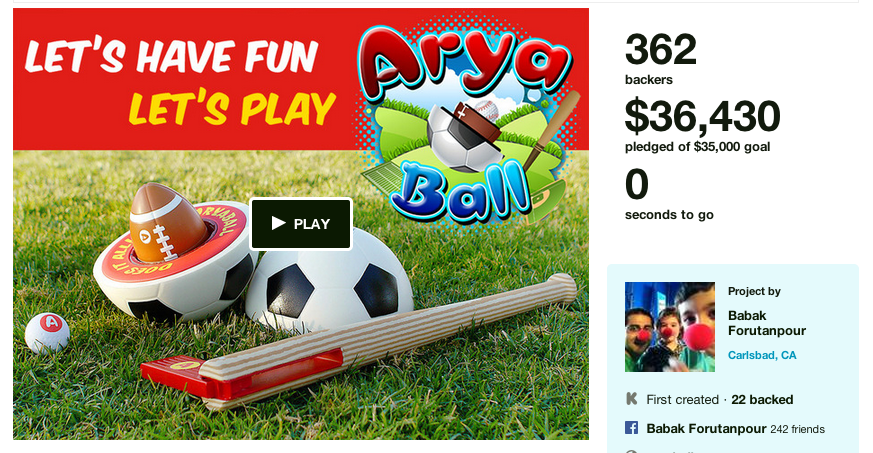I first met Babak Forutanpour and his innovative 5-in-1 sports product, AryaBall, when he reached out to me through CrowdfundingPR, asking us help create a media list for his campaign. Many creators approach me during the middle of their campaign, when it’s hardest to have the most amount of impact. However, Babak reached out long before the campaign even started. I was impressed.
I think his preparation techniques and “lessons learned” from running a campaign are tips everybody ought to know before starting a Kickstarter. Check out our interview below, and be sure to like AryaBall on Facebook and subscribe to their interest list. They are currently fulfilling their Kickstarter rewards, but will soon be offering AryaBall to the public. It’s an awesome and fun product for families and children.
What others have said:
“More convenient AND less expensive than buying all that stuff separately? I’m so buying 2!” – Shally Zomorodi, Fox5 News.
“Oh my God!” – Kathie Lee Gifford, NBC Today
“Clever way to get app-addicted kids a little more active.” Gizmodo.
What kind of preparation did you do for the campaign?
Even before the final prototype was complete or we started shooting the Kickstarter video, I felt it would be good to start sharing the story of the ball with non family and friends to get honest feedback and help build our network. I started blogging at @thearyaball on Facebook, Twitter and Instagram, and we were excited to see that our teaser video of the 4-in-1 ball (the Frisbee came later) got over 5,000+ hits!
My wife and I then started building a list of influential people in children and toy circles who might want to review what we believe is the world’s most fun ball and bat. Given that we both have day jobs and are parents to young twins with school, ballet, piano, Farsi, and football practice, it was challenging, but a little bit of preparation every night ended up going a very long way.
Sal’s Note: You have no excuse not to prepare if they were able to juggle all these tasks and still find time for it!
But we knew early on that the key to a successful launch is not just a strong contact list, but making personal connections. For that, you have to hit the road and start meeting people, telling your story, and seeing if it resonates with them, and learning how you can in turn help them reach their dreams.
With a rough prototype in hand, I hit tens of shows, conferences, maker fairs, and pitch fests. Winning some awards along the way helped validate that I was not crazy using my 3D printer to stuff foam balls inside each other.
You did a lot of preparation leading up to Kickstarter. Did this pay off?
All that preparation certainly paid off. By getting out there and telling our story, we soon started to see some great traction. The folks at SD Maker Faire took us on their road show to TheCW 6 and then KUSI 9. We then got on FOX5. Some passionate mommy bloggers who felt our inventions solves a real problem for their readers covered us, never asking for anything in return. Getting picked up by Today Show for their Hot New Toys at New York Toy Faire was just mind-blowing.
How did you go about maintaining momentum throughout the campaign?
I timed the Kickstarter to launch a week before the NY Toy Fair. This way, once the initial build up of interest had passed through, we would hopefully get a boost from having a small booth at the show. That is how NBC found us, which was a real nice boost. Bloggers from Gizmodo and the ToyBook also came by our booth and ran an article to help us build our momentum.
We also did a lot of social media via Twitter, a fundraiser with a local school, Arya and I hit the football fields after games to hand out flyers, and asked friends and family to ping their networks from time to time. It was really nice when my employer Qualcomm got behind my family and posted a story on their Facebook and LinkedIn pages.
What were the top 3-4 traffic sources and pledge sources for your campaign?
The first most popular traffic source was a link from our website, so it is hard to exactly know how they found us as Google Analytics shows they either knew the url or typed “arya ball”. The 2nd most popular traffic source was a direct link to our Kickstarter page, which shows our list of contacts, which in turn forwarded those email to their network worked really well.
You guys have been featured on several publications. Do you have any tips on getting PR?
To be honest, and I say this because I have tried to start several business in the past, all of which failed, I think the #1 way to get coverage is with a great product or service.
PR and emails and cold calls and flyers and asking for introductions will only get you so far. If what you are offering is not novel or useful at a reasonable price, you are done, or at least better plan for a huge marketing budget to educate the market on the benefits of your solution.
That is why I believe in the lean startup model of building a MVP (The Lean Startup: How Today’s Entrepreneurs Use Continuous Innovation to Create Radically Successful Businesses), minimum viable product, and seeing if it gets traction. If it does, you then take the next step, if it doesn’t, move on to your next idea, which is more pull than push.
What was the hardest part about the campaign? Any parts of the process that surprised you?
For me, none of it was hard because I did it to feed my curiosity. When you do something for fun, it doesn’t feel like work, despite the long hours and burning most of your vacation time at work!
What I did not expect is my daughter Darya coming to me and saying she is proud of me. Telling your kids to “work hard” is nice, but them seeing it is makes more of an impact. I am hoping this experience teaches my kids the value of grit.
How would you describe the Kickstarter community or fundraising process to a stranger?
Getting people to retweet you, or ‘like’ your Facebook page, or share your youTube video is a great way to see if what you have created something cool. However, asking someone to spend $38 of their hard earned money to buy some foam, that they have to wait until November to even get, is where you really start to see if there is genuine demand for your product.
Kickstarter is not only a great site to help with raising the money you need for tooling and other startup costs associated with manufacturing, but it will help value the opportunity cost of your venture.
More Stats Below From the Kickstarter Short-Link
My Question For You!
Did you find this article to be helpful? Be sure to support AryaBall by linking them on Facebook!









